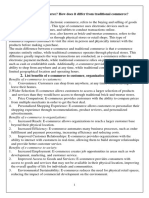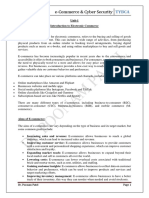0% found this document useful (0 votes)
21 views11 pagesDocs
The document provides a comprehensive overview of e-commerce, including its definition, types, benefits, challenges, and requirements for effective operation. It highlights the significance of e-commerce in modern business, emphasizing convenience, global reach, and cost efficiency for both consumers and businesses. Additionally, it discusses consumer buying behavior on platforms like Amazon and Flipkart, driven by factors such as accessibility, competitive pricing, and personalized experiences.
Uploaded by
jsdhaliwal3997Copyright
© © All Rights Reserved
We take content rights seriously. If you suspect this is your content, claim it here.
Available Formats
Download as PDF, TXT or read online on Scribd
0% found this document useful (0 votes)
21 views11 pagesDocs
The document provides a comprehensive overview of e-commerce, including its definition, types, benefits, challenges, and requirements for effective operation. It highlights the significance of e-commerce in modern business, emphasizing convenience, global reach, and cost efficiency for both consumers and businesses. Additionally, it discusses consumer buying behavior on platforms like Amazon and Flipkart, driven by factors such as accessibility, competitive pricing, and personalized experiences.
Uploaded by
jsdhaliwal3997Copyright
© © All Rights Reserved
We take content rights seriously. If you suspect this is your content, claim it here.
Available Formats
Download as PDF, TXT or read online on Scribd
/ 11





















































































